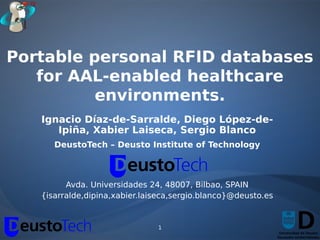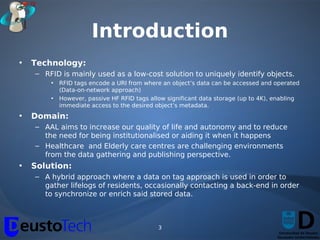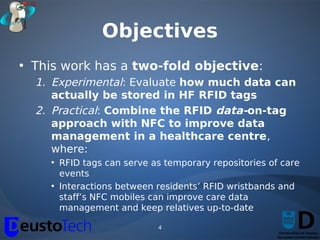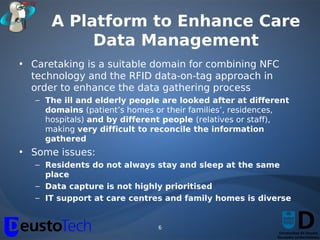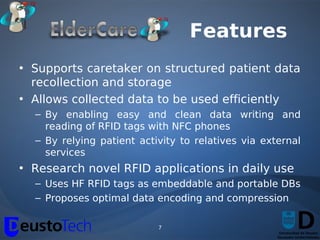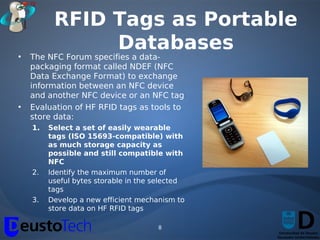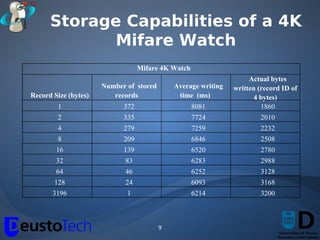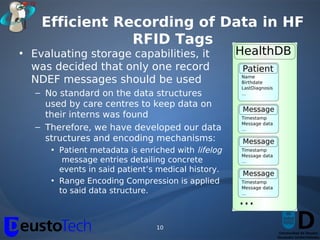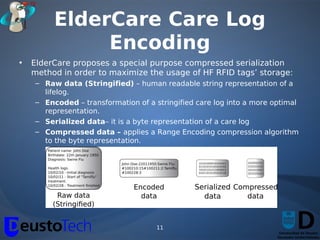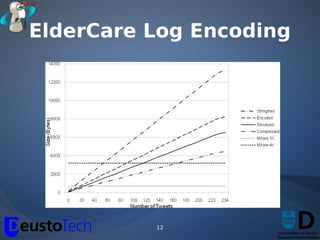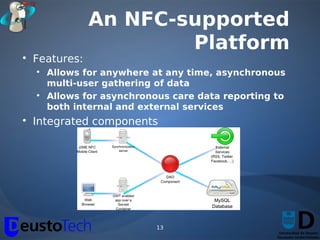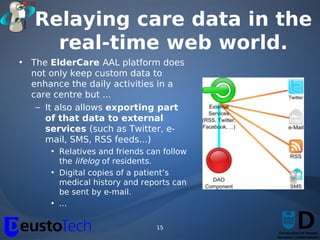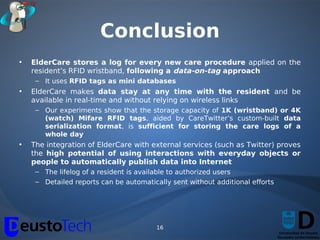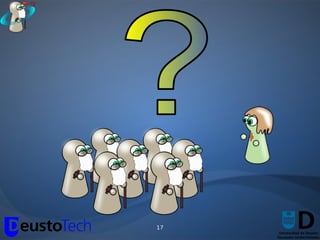Elder care iwaal
- 1. Portable personal RFID databases for AAL-enabled healthcare environments. Ignacio DÃaz-de-Sarralde, Diego LÃģpez-de- IpiÃąa, Xabier Laiseca, Sergio Blanco DeustoTech â Deusto Institute of Technology Avda. Universidades 24, 48007, Bilbao, SPAIN {isarralde,dipina,xabier.laiseca,sergio.blanco}@deusto.es 1
- 2. Contents âĒ Introduction âĒ Objectives âĒ Related Work âĒ An NFC-supported platform: âĒ RFID tags as portable databases âĒ Relaying care data in the real-time web world âĒ Conclusion âĒ Further questions 2
- 3. Introduction âĒ Technology: â RFID is mainly used as a low-cost solution to uniquely identify objects. âĒ RFID tags encode a URI from where an objectâs data can be accessed and operated (Data-on-network approach) âĒ However, passive HF RFID tags allow significant data storage (up to 4K), enabling immediate access to the desired objectâs metadata. âĒ Domain: â AAL aims to increase our quality of life and autonomy and to reduce the need for being institutionalised or aiding it when it happens â Healthcare and Elderly care centres are challenging environments from the data gathering and publishing perspective. âĒ Solution: â A hybrid approach where a data on tag approach is used in order to gather lifelogs of residents, occasionally contacting a back-end in order to synchronize or enrich said stored data. 3
- 4. Objectives âĒ This work has a two-fold objective: 1. Experimental: Evaluate how much data can actually be stored in HF RFID tags 2. Practical: Combine the RFID data-on-tag approach with NFC to improve data management in a healthcare centre, where: âĒ RFID tags can serve as temporary repositories of care events âĒ Interactions between residentsâ RFID wristbands and staffâs NFC mobiles can improve care data management and keep relatives up-to-date 4
- 5. Related Work âĒ NFC technology operating on 13.56MHz combines the functionality of a RFID reader device and a RFID transponder into one integrated circuit â NFC read/write mode allows NFC devices to access data from an object with an embedded RFID tag âĒ The combination of NFC technology and RFID tags has been used in the last few years in several research projects related to medicine and caretaking â However, so far RFID applications have not incorporated custom data directly onto RFID tags âĒ Still prevails a generic lack of standardization, only alleviated by initiatives such as the Continua Health Alliance 5
- 6. A Platform to Enhance Care Data Management âĒ Caretaking is a suitable domain for combining NFC technology and the RFID data-on-tag approach in order to enhance the data gathering process â The ill and elderly people are looked after at different domains (patientâs homes or their familiesâ, residences, hospitals) and by different people (relatives or staff), making very difficult to reconcile the information gathered âĒ Some issues: â Residents do not always stay and sleep at the same place â Data capture is not highly prioritised â IT support at care centres and family homes is diverse 6
- 7. Features âĒ Supports caretaker on structured patient data recollection and storage âĒ Allows collected data to be used efficiently â By enabling easy and clean data writing and reading of RFID tags with NFC phones â By relying patient activity to relatives via external services âĒ Research novel RFID applications in daily use â Uses HF RFID tags as embeddable and portable DBs â Proposes optimal data encoding and compression 7
- 8. RFID Tags as Portable Databases âĒ The NFC Forum specifies a data- packaging format called NDEF (NFC Data Exchange Format) to exchange information between an NFC device and another NFC device or an NFC tag âĒ Evaluation of HF RFID tags as tools to store data: 1. Select a set of easily wearable tags (ISO 15693-compatible) with as much storage capacity as possible and still compatible with NFC 2. Identify the maximum number of useful bytes storable in the selected tags 3. Develop a new efficient mechanism to store data on HF RFID tags 8
- 9. Storage Capabilities of a 4K Mifare Watch Mifare 4K Watch Actual bytes Number of stored Average writing written (record ID of Record Size (bytes) records time (ms) 4 bytes) 1 372 8081 1860 2 335 7724 2010 4 279 7259 2232 8 209 6846 2508 16 139 6520 2780 32 83 6283 2988 64 46 6252 3128 128 24 6093 3168 3196 1 6214 3200 9
- 10. Efficient Recording of Data in HF RFID Tags âĒ Evaluating storage capabilities, it was decided that only one record NDEF messages should be used â No standard on the data structures used by care centres to keep data on their interns was found â Therefore, we have developed our data structures and encoding mechanisms: âĒ Patient metadata is enriched with lifelog message entries detailing concrete events in said patientâs medical history. âĒ Range Encoding Compression is applied to said data structure. 10
- 11. ElderCare Care Log Encoding âĒ ElderCare proposes a special purpose compressed serialization method in order to maximize the usage of HF RFID tagsâ storage: â Raw data (Stringified) â human readable string representation of a lifelog. â Encoded â transformation of a stringified care log into a more optimal representation. â Serialized dataâ it is a byte representation of a care log â Compressed data â applies a Range Encoding compression algorithm to the byte representation. 11
- 12. ElderCare Log Encoding 12
- 13. An NFC-supported Platform ïŽ Features: ïŽ Allows for anywhere at any time, asynchronous multi-user gathering of data ïŽ Allows for asynchronous care data reporting to both internal and external services ïŽ Integrated components 13
- 14. ElderCare Mobile Client 14
- 15. Relaying care data in the real-time web world. âĒ The ElderCare AAL platform does not only keep custom data to enhance the daily activities in a care centre but ... â It also allows exporting part of that data to external services (such as Twitter, e- mail, SMS, RSS feeds...) âĒ Relatives and friends can follow the lifelog of residents. âĒ Digital copies of a patientâs medical history and reports can be sent by e-mail. âĒ ... 15
- 16. Conclusion âĒ ElderCare stores a log for every new care procedure applied on the residentâs RFID wristband, following a data-on-tag approach â It uses RFID tags as mini databases âĒ ElderCare makes data stay at any time with the resident and be available in real-time and without relying on wireless links â Our experiments show that the storage capacity of 1K (wristband) or 4K (watch) Mifare RFID tags, aided by CareTwitterâs custom-built data serialization format, is sufficient for storing the care logs of a whole day âĒ The integration of ElderCare with external services (such as Twitter) proves the high potential of using interactions with everyday objects or people to automatically publish data into Internet â The lifelog of a resident is available to authorized users â Detailed reports can be automatically sent without additional efforts 16
- 17. 17
